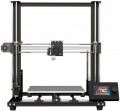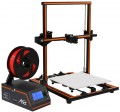Object dimensions (HxWxD)
The maximum dimensions of a product that can be printed on a 3D printer in one cycle.
The larger the dimensions of the model, the wider the choice for the user, the greater the variety of sizes available for printing. On the other hand, "large-sized" printers take a lot of space, and this parameter significantly affects the cost of the device. In addition, while printing a large model with FDM/FFF (see "Printing Technology"), larger nozzles and higher print speeds are desirable — and these features negatively affect detailing and the print quality of tiny objects. Therefore, while choosing, you should not aim the utmost maximum sizes — you should realistically assess the dimensions of the objects that you're going to print, and proceed from these data (plus a small margin in case of unexpected moments). In addition, we note that a large product can be printed in parts, and then piece these parts together.
Object volume
The largest volume of an object that can be printed on a printer. This indicator directly depends on the maximum dimensions (see above) — usually, it corresponds to these dimensions multiplied by each other. For example, dimensions of 230x240x270 mm will correspond to a volume of 23*24*27 = 14,904 cm³, that is, 14.9 litres.
The exact meaning of this indicator depends on the printing technology used (see above). These data are fundamental for photopolymer technologies SLA and DLP, as well as for powder SHS: the volume of the model corresponds to the amount of photopolymer/powder that needs to be loaded into the printer to print the product to the maximum height. If the size is smaller, this amount may decrease proportionally (for example, printing a model at half the maximum height will require half the volume), however, some printers require a full load regardless of the size of the product. In turn, for FDM/FFF and other similar technologies, the volume of the model is more of a reference value: the actual material consumption there will depend on the configuration of the printed product.
As for specific figures, the volume
up to 5 litres can be considered as small,
from 5 to 10 litres — medium,
more than 10 litres — large.
Power
Rated input power of the printer, in fact — the highest power consumed by the device in regular operation.
This indicator is directly related to the specs of the device, primarily the overall performance. However, generally, 3D printers are a relatively economical devices: among solutions that are not related to specialized industrial equipment, values of more than 1 kW are extremely rare, and even in the most performant models this figure does not exceed 3 kW. For such capacities, an ordinary household power outlet is quite enough, so you have to pay attention to power consumption mainly in specific cases — for example, when assessing the load on a voltage stabilizer or a backup power source.

